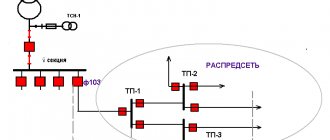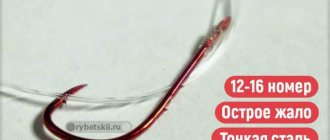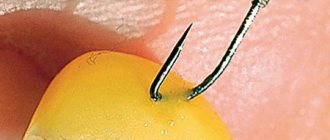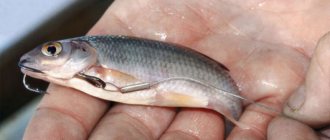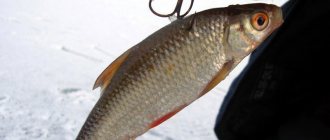Yuri 07.12.2020 520
Self-snapping or self-striking hooks in fishing are not new. They appeared quite a long time ago and are used in almost all types of fishing. But not everyone knows how to use them. Based on my experience, I decided to share theoretical information, observations, and also talk about the types of self-hooks and their differences.
What hooks to put on the feeder and the principle of choice
When coming to a fishing store, it is difficult for a beginner to choose hooks for feeder fishing, since the assortment is wide. Let us note right away that you won’t be able to choose a universal option, which means you need to buy more than one pack. The minimum is 5-6 packs.
There is a misconception that the feeder hook is selected based on the fish you plan to catch. If you are fishing for bream, then select an accessory for it. This is wrong. The hook is selected to match the bait, and then the planned catch and fishing conditions are considered.
Remember that the hook is a consumable item and will usually need to be replaced more than once during fishing. Therefore, stock up on hooks if you are in the mood for the feeder season. Over the course of the season, you will figure out which hooks are best to place on the feeder and which ones are suitable for you personally. Because this is such an individual thing that sometimes it even matches the hooking technique of an individual angler. For some, one model is great, but for others it is unsuitable for fishing. It's a paradox, but it's true.

Design features and fundamental differences
Self-locking fish hooks have been developed based on extensive experience, thereby solving the above problems. The main difference between such hooks is that when biting, provided that the tackle is set up correctly, the fish is caught by the sting on its own. This is achieved due to the design features of such hooks, namely the circular shape and the sting bent inward, up to 90 degrees to the fore-end, which expands its functionality and provides new opportunities for operation relative to the hook of the classic configuration.
How to choose the size
More often, beginners select hooks only based on size, and consider this the main factor when choosing. There is truth in this, but there are other factors. Different sizes are also needed if the fisherman wants to successfully fish. You can’t go to the store, pick up five medium-sized packs and assume that you’re covered for the season.
Taking into account various attachments and baits, types of fish, fishing conditions in different bodies of water. It is recommended to use hooks from 8 to 18 numbers during the season. Most often these are numbers 10, 12, 14 and 16 according to European qualification, when the higher the number, the smaller the hook. However, in some stores there is a situation where the smaller the number, the smaller the hook.
Numbers 14 and 16 are usually used for catching small fish with a feeder, for example, on a still body of water. Bloodworms attach well to such hooks and do not spread. These sizes of fishing hooks are suitable, for example, for catching roach with a feeder, bleak, and bream.
But number 18 is rarely used by beginners; more often it is used by athletes to catch small fish at speed. Not to mention number 20, which is no longer used by athletes so often.
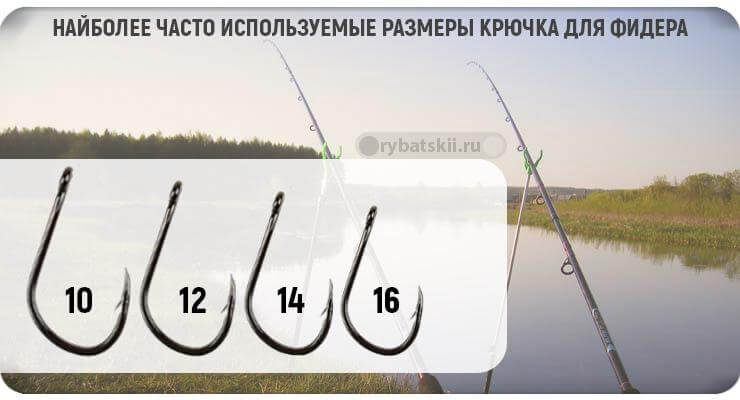
Numbers 8, 10 and 12 are already suitable for catching large fish such as bream, crucian carp, carp or chub. These sizes are already used more often when fishing with a feeder on the river, where the fish are larger and stronger. You can already attach baits such as a worm, maggot, peas, corn, and also make so-called “sandwiches”. For example, on number 10, 2–3 maggots and bloodworms are planted. On number 8 they already put several maggots and a worm or 2 parts of a worm, which can already attract large bream or other trophy fish. They can withstand the load when fishing for trophies. Unless, of course, it’s a Chinese fake that can be unbent by hand.
Examples of gear used: self-cutting fishing hooks
Roller-type equipment for pike fishing
Despite the fact that self-cutting hooks are more common when catching peaceful fish of the carp family, an example can be given of how to use them when catching a predator, such as pike, perch, pike perch or burbot. For this purpose, a “skating rink” type tackle is used.
The design of this fishing tool is simple and consists of the following elements:
- float-cylinder made of hard foam 18 cm in length and 6 cm in diameter and a cut for fastening the fishing line in the end part;
- fishing line of the required length, wound in the center of the float;
- olive shaped sinker;
- retractable leashes on carabiners, equipped with self-locking hooks.
We recommend reading: How to choose the best spinning rod for twitching, rating of models
The principle of fishing with such gear is similar to fishing with mugs, but has the advantage that it works even in windy weather. The sinker creates enough tension so that with a sharp jerk the predator sits on the hook. After fishing, the leash with the fish is unfastened from the main fishing line, replaced with a new one, and fishing continues.
Feeder self-cutting tackle
There are three options for using self-cutting tackle together with a feeder, although they are only suitable for reservoirs with standing water.
First option. It is the most popular and is actually a paternoster equipped with a short leash, the difference being the sinker, which changes to a weighted swim feeder. In this design, the fishing gear works very effectively when hunting roach, practically eliminating empty bites. The length of the leash is about half a meter, and the weight of the feeder is 50 grams; it is filled with animal bait. After casting, the line is tightened and a heavy bite alarm is installed.
Second option. Unlike the first option, this equipment consists of more elements:
- main line with a size 18 feeder attached to it;
- a leash with a self-closing hook is fastened from the feeder at a distance of half a meter;
- at the very end of the tackle a bombard weighing 50 grams is installed.
It is important to remember that with such heavy equipment, hooking is not only not required, but is generally dangerous, since it can lead to breakage of the working line. Notching and fishing are done smoothly and slowly, slightly reeling in the line.
Since the feeders have a considerable mass, to cast them, the tensile strength of the fishing line must be at least 3 kg. To protect the working leash with a strength of 1 kg, a spacer made of durable elastic material is used, which acts as a shock absorber.
Third option. This option is justified when fishing for carp. A large feeder feeder is attached to the end of the main line, and a self-cutting fishing hook is mounted just above it, on a very short leash.
The fishing technique is to fill the feeder with bait until a dense ball is formed. A hook is inserted into this ball, on which bait is pre-attached and camouflaged. The careful fish does not notice the line of the leash and begins to eat the bait with appetite, among which bait with a hook appears unnoticed. When the fish senses danger and suddenly swims to the side, it will hook itself. Using this method, the largest and most cautious carp are caught.
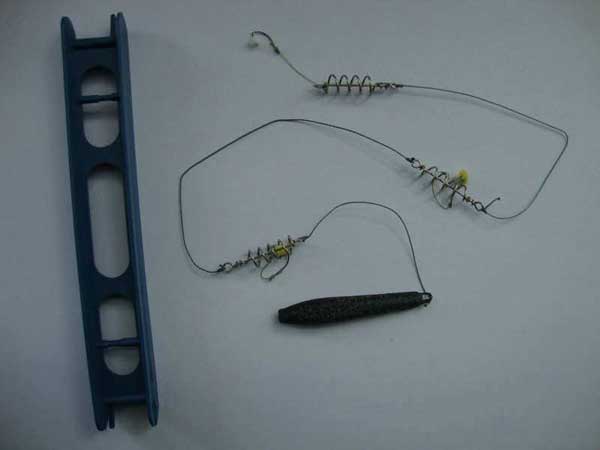
Do-it-yourself self-cutting tackle
- It is necessary to prepare diverting leashes with special hooks, a weight or feeder with a mass calculated from the mass of the expected fish caught, as well as accessories in the form of swivels, carabiners, shock absorbers and beads.
- The next step is to tie the swivel to the leash, and attach it to the main fishing line using a link from a carabiner with a bead and a shock-absorbing cambric.
- At the last stage, it is necessary to tie a feeder or a weight corresponding to the type of fishing to the end of the fishing line.
It should also be remembered that it is always necessary to adjust the drag on the reel if there is a lot of hiding place for fish in the reservoir. The rod must always be visible and within reach in order to exercise control over it. It is advisable to place it in your hand or a special holder, otherwise a large individual may drag it into the water with it, since a fish caught on a self-sustaining hook will no longer be able to get off it.
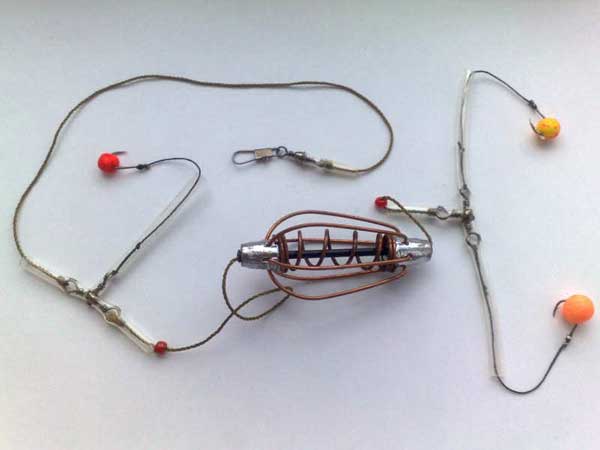
Form
The shape of the hook for feeder fishing, according to fishermen, is also an individual nuance and even depends on the fisherman’s hooking technique. Therefore, here everyone decides for himself, but it is worth knowing first of all about the two standard forms. These are classic and round models.
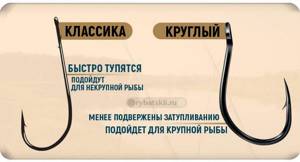
The classic is when the hook runs parallel to the fore-end. In practice, such hooks become dull faster when fishing with a feeder, but if you bend it slightly to the side, then it’s a completely workable option. Do what is called a side fold. By the way, there are models that initially come with such a side hem. It should be a little crooked and then it won’t dull so quickly, and it will also cut better.
Round models with the sting inward dull less and this is their advantage, and they also hold fish well. Therefore, it is recommended that beginners take a closer look at this option, but they should not write off the classics. Try both options. For example, round models will be more suitable for bream, but for roach, the classic ones will still be a more interesting option.
Features of different undercutters
Depending on the type of fishing in which self-hookers are used, they have different design features:
- The presence of fasteners for the fishing rod. For feeder self-cutters, the presence of fasteners for the blank is mandatory, while for classic bottom tackle on a reel, fasteners in the design of this device are not required;
- Spring elastic force;
- Features and force of trigger mechanism. The design and triggering force of the self-hooking trigger depends on the type of gear and the weight of the intended catch.
Read: Self-hooking spinning rods
Wire thickness
If you plan to fish on a stagnant body of water, where mostly small fish bite, and bloodworms will be used as bait, then choose a series with a thinner wire.
Nowadays, even on packs, many manufacturers indicate wire thickness and weight, but it’s difficult to navigate using such data. Over time, you will be able to determine the thickness by eye. For cautious small fish, such a hook is easier to swallow and does not arouse suspicion. You may not believe it, but the fish knows what the weight of the bait should be; if it feels an excessively heavy hook, it quickly gets rid of it and it is extremely difficult to detect it.
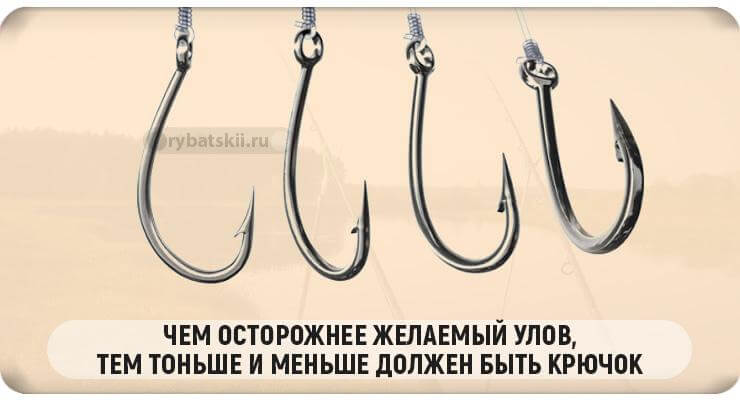
When fishing on a river, where the fish are more lively and strong, and a larger bait is used, use a thicker hook. In such conditions, there is no point in fishing with one bloodworm and using a thin accessory with thin wire that is not suitable for either the bait or the planned catch.
Purpose of self-cutters
A self-hooking device is a device designed to perform hooking at a certain tension force on the fishing line or cord when a fish bites. Self-cutters are used in the following cases:
- With a large amount of gear. If an angler fishes with 4-5 feeders, then he will not be able to equally monitor each tackle. In this case, he will be helped by self-cutters who will perform the sweeps for him;
- When fishing at night. At night, automatic hookers will give you the opportunity to sleep for a couple of hours and not worry that the bite will be missed;
- With a weak bite. When the fish is inactive, it is easier for the fisherman to install all the gear in the self-hooking hooks, adjust them for a weak bite and fish at this time with a float rod;
Do not use self-hookers when the bite is active - in this case, the fisherman will spend a lot of time reloading the very quickly triggered self-hookers. In this case, it will be easier to hook manually and fish with no more than 3 feeders.
With a ring or spatula
Of course, this moment does not affect the bite, but it can affect the final catch. Crochet hooks with a spatula are considered more reliable, but they are less attractive to beginners due to the inability to knit them. Therefore, we recommend that you learn how to knit patterns with a spatula once and give preference to them more often. When knitting, use a hook or loop stitch.
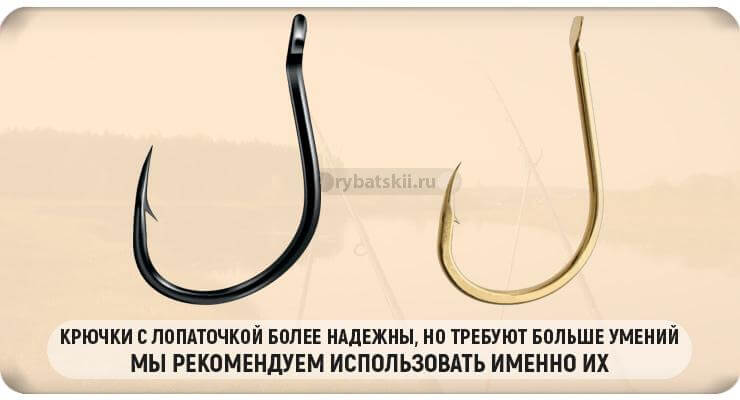
Hooks with a ring, especially small ones, are less reliable from a technological point of view. When making and bending the ring, the metal may not be made correctly. This can affect fishing at the wrong time. Or the sharp edge damages the fishing line, which is especially true for small hooks with a ring.
How often to change hooks
There are fishermen who change the hook after each bream they catch, not considering it necessary to risk a new potential trophy for 10 rubles. Perhaps you shouldn’t do something so radical, but if you notice that you can’t hook, then changing the hook is necessary. Even high-quality hooks lose their sharpness, which means they should be changed periodically. Ideally, the more often the better, but how often everyone decides for themselves. Based on its range and capabilities. It's still a consumable item.



